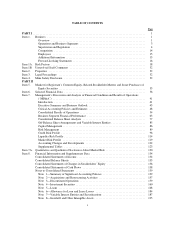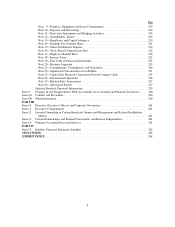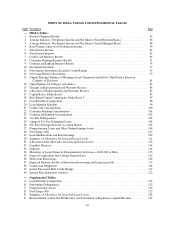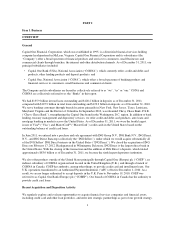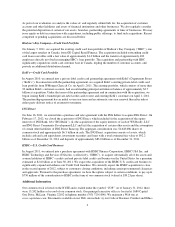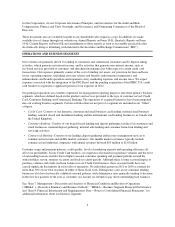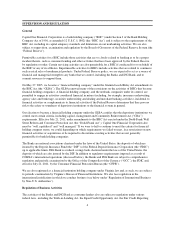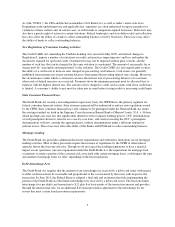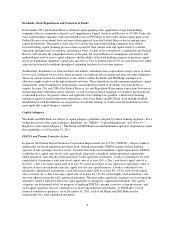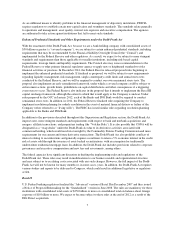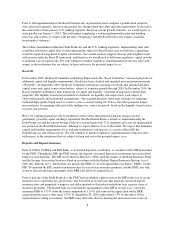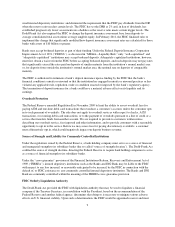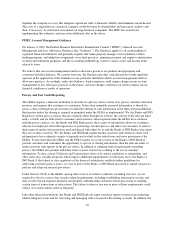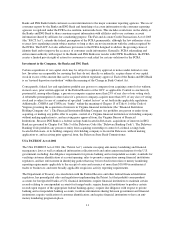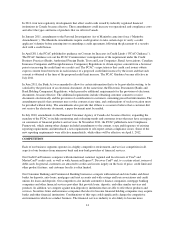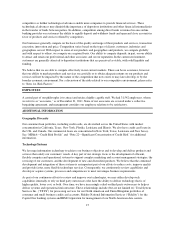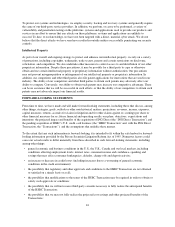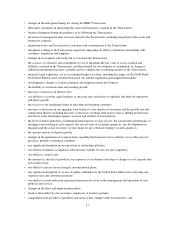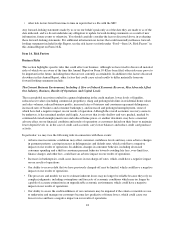Capital One 2011 Annual Report Download - page 28
Download and view the complete annual report
Please find page 28 of the 2011 Capital One annual report below. You can navigate through the pages in the report by either clicking on the pages listed below, or by using the keyword search tool below to find specific information within the annual report.Prior to full implementation of the Basel II framework, organizations must complete a qualification period of
four consecutive quarters, known as the parallel run, during which they must meet the requirements of the rule to
the satisfaction of their primary U.S. banking regulator. Based on current growth estimates, we would expect to
enter parallel run January 1, 2015. This will require completing a written implementation plan and building
processes and systems to comply with the rules. Compliance with the Basel II rules will require a material
investment of resources.
The Collins Amendment within the Dodd-Frank Act and the U.S. banking regulators’ implementing final rules
establish a risk-based capital floor so that organizations subject to Basel II rules may not hold less capital than
would be required using Basel I capital calculations. Our current analysis suggests that our risk-weighted assets
will increase under the Basel II framework, and therefore we would need to hold more regulatory capital in order
to maintain a given capital ratio. We will continue to monitor regulators’ implementation of the new rules with
respect to the institutions that are subject to them and assess the potential impact to us.
Basel III
In December 2009, the Basel Committee on Banking Supervision (the “Basel Committee”) released proposals for
additional capital and liquidity requirements, which have been clarified and amended in recent pronouncements
(“Basel III”). In September 2010, the Basel Committee announced a package of reforms that included detailed
capital ratios and capital conservation buffers, subject to transition periods through 2018. In December 2010, the
Basel Committee published a final framework on capital and liquidity, consistent in large part with the prior
proposals. The liquidity framework included two standards for liquidity risk supervision, each subject to
observation periods and transitional arrangements. One standard promotes short-term resilience by requiring
sufficient high-quality liquid assets to survive a stress scenario lasting for 30 days; the other promotes longer-
term resilience by requiring sufficient stable funding over a one-year period, based on the liquidity characteristics
of assets and activities.
How U.S. banking regulations will be modified to reflect these international standards remains unclear,
particularly given the capital surcharge regulations that the Federal Reserve intends to implement under the
Dodd-Frank Act and the current Prompt Corrective Action framework. U.S. regulators have not yet implemented
any portion of the Basel III framework, although we expect them to do so in the future. We expect that minimum
capital and liquidity requirements for us and other institutions will increase as a result of Basel III, the
Dodd-Frank Act and related activity. We will continue to monitor regulators’ implementation of the new rules
with respect to the institutions that are subject to them and assess the potential impact to us.
Deposits and Deposit Insurance
Each of CONA, COBNA and ING Bank, as an insured depository institution, is a member of the DIF maintained
by the FDIC. Through the DIF, the FDIC insures the deposits of insured depository institutions up to prescribed
limits for each depositor. The DIF was formed on March 31, 2006, upon the merger of the Bank Insurance Fund
and the Savings Association Insurance Fund in accordance with the Federal Deposit Insurance Reform Act of
2005 (the “Reform Act”). The Reform Act permits the FDIC to set a Designated Reserve Ratio (“DRR”) for the
DIF. To maintain the DIF, member institutions may be assessed an insurance premium, and the FDIC may take
action to increase insurance premiums if the DRR falls below its required level.
Prior to passage of the Dodd-Frank Act, the FDIC had established a plan to restore the DIF in the face of recent
insurance losses and future loss projections, which resulted in several rules that generally increased deposit
insurance rates and purported to improve risk differentiation so that riskier institutions bear a greater share of
insurance premiums. The Dodd-Frank Act reformed the management of the DIF in several ways: raised the
minimum DRR to 1.35% (from the former minimum of 1.15%) and removed the upper limit on the DRR;
required that the reserve ratio reach 1.35% by September 30, 2020 (rather than 1.15% by the end of 2016);
required that in setting assessments, the FDIC must offset the effect of meeting the increased reserve ratio on
8


